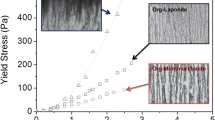Abstract
This paper deals with the use of Stern theory as applied to a clay-water electrolyte system, which is more realistic to understand the force system at micro level than the Gouy-Chapman theory. The influence of the Stern layer on potential-distance relationship has been presented quantitatively for certain specified clay-water systems and the results are compared with the Gouy-Chapman model. A detailed parametric study concerning the number of adsorption spots on the clay platelet, the thickness of the Stern layer, specific adsorption potential and the value of dielectric constant of the pore fluid in the Stern layer, was carried out. This study investigates that the potential obtained at any distance using the Stern theory is higher than that obtained by the Gouy-Chapman theory. The hydrated size of the ion is found to have a significant influence on the potential- distance relationship for a given clay, pore fluid characteristics and valence of the exchangeable ion.
Similar content being viewed by others
References
Bolt GH. 1956. Physicochemical analysis of compressibility of pure clays geotechnique. London: Institution of Civil Engineers. 6:86–93.
Conway BE, Bockris JO’M, Ammar IA. 1951. The Dielectric constant of the solution in the diffuse and helmholtz interface in aqueous solution. Trans Faraday Soc. London 47:756–766.
Cownie A, Palmer LS. 1952. The effect of moisture on the electrical properties of soil. Proc Phys Soc London 65B: 295–301.
Grim RE. 1962. Applied clay mineralogy. New York: McGraw-Hill. 422 p.
Lambe TW, Whitman RW. 1969. Soil mechanics. New Delhi: Wiley Eastern. 553 p.
Low PF., 1959. Discussion on physio-chemical properties of soils: Ion exchange phenomena. J Soil Mech & Found Div ASCE 85, No. SM 2:79 p.
Mitchel JK. 1976. Fundamentals of soil behaviour. New York: John Wiley. 422 p.
Olsen RE, Mesri G. 1970. Mechanisms controlling compressibility of clays. J Soil Mech & Found Div ASCE: 96, No. SM 6:1863–1878.
Palmer LS. 1952. Dielectric constant of water in wet clay, Proc Phys Soc London 65B:674–678.
Palmer LS, Cunliffe A, Hough JM. 1952. Dielectric constants of water films. Nature 170:796 p.
Sridharan A. 1968. Some studies on the strength of partly saturated clays. [Ph.D. Thesis]. West Lafayette: Purdue University. 179 p.
Sridharan A, Jayadeva MS. 1982. Double layer theory and compressibility of clays. Geotechnique (London) 32:133–144.
van Olphen H. 1963. Clay colloid chemistry. New York: Interscience. 301 p.
Verwey EJW, Overbeek JThG. 1948. Theory of the stability of the lyophobic colloids. Amsterdam: Elsevier. 205 p.
Author information
Authors and Affiliations
Rights and permissions
About this article
Cite this article
Sridharan, A., Satyamurty, P.V. Potential-Distance Relationships of Clay-Water Systems Considering the Stern Theory. Clays Clay Miner. 44, 479–484 (1996). https://doi.org/10.1346/CCMN.1996.0440405
Received:
Accepted:
Published:
Issue Date:
DOI: https://doi.org/10.1346/CCMN.1996.0440405



